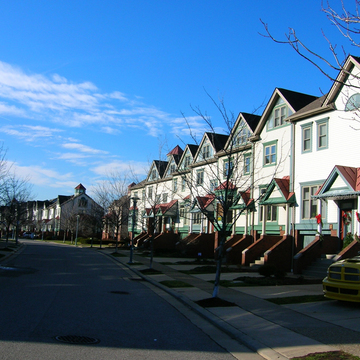You are here
Washington's Landing (Herr's Island)
The forty-two acres of Herr's Island, two miles upstream from the Golden Triangle, entered history in 1753 when George Washington nearly drowned near here. A century later, Benjamin Herr made a fitful start at developing the island into a village of tree-lined streets, homes, shops, and recreational areas. But Herr's village was taken over by industry in the 1850s, and given its first stockyards by tanner James Callery in 1885. In 1903, the Pennsylvania Railroad erected huge metal-roofed livestock pens on half of the island, turning it into one of the key livestock and slaughterhouse complexes in the nation. The railroad and the food processors abandoned Herr's Island in the 1960s, leaving behind a scrap yard, slaughterhouse, livestock auction house, soap works, rendering plant, and one hundred empty cattle pens.
After rusting for thirty years, the old installations were torn out as planners rebaptized the island Washington's Landing. The intent was to use neotraditional town planning to create a multiuse urban village, with adjacent areas for offices, light industry, and recreational use all within walking distance. Millions of dollars of public and private funds and intense collaboration between public and private planners and developers combined to create such a village fifteen years later, in 1989. Traditional house types and materials give a consistent architectural continuity to the sycamore-lined streets of the village at the southern end of the island, with its ninety town houses of brick and clapboard siding. The usual rows of identical town houses have been eliminated here by clusters of homes that are identified by distinctive bay windows, columned porches, and gabled roofs with cupolas.
Though Washington's Landing resembles such neotraditional projects as Duany Plater-Zyberk and Company's (DPZ) Florida town of Seaside, it differs from them by being located inside a major city, and being a true multiuse plan. Its commercial tenants were attracted to the island by its recreational facilities, and the homeowners—mainly ex-suburbanites or newcomers to Pittsburgh—extol their fiveminute walks to work, or boating and rowing. The island's seven-acre public park provides bike paths and jogging trails, which in turn link to the north shore and the Three Rivers Heritage Trail by a converted nineteenth-century railroad bridge.
Writing Credits
If SAH Archipedia has been useful to you, please consider supporting it.
SAH Archipedia tells the story of the United States through its buildings, landscapes, and cities. This freely available resource empowers the public with authoritative knowledge that deepens their understanding and appreciation of the built environment. But the Society of Architectural Historians, which created SAH Archipedia with University of Virginia Press, needs your support to maintain the high-caliber research, writing, photography, cartography, editing, design, and programming that make SAH Archipedia a trusted online resource available to all who value the history of place, heritage tourism, and learning.


